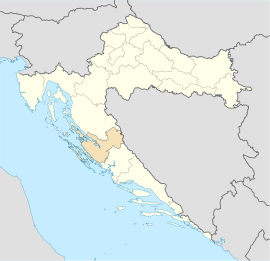Benkovac
| Benkovac | ||
|
||
|
|
||
| Basic data | ||
|---|---|---|
| State : |
|
|
| County : |
|
|
| Area : | 514 km² | |
| Residents : | 11,026 (2011) | |
| Population density : | 21 inhabitants per km² | |
| Telephone code : | (+385) 023 | |
| Postal code : | 23 420 | |
| License plate : | ZD | |
| Structure and administration (status: 2013, cf. ) |
||
| Community type : | city | |
| Mayor : | Branko Kutija ( HDZ ) | |
| Postal address : | Šetalište kneza Branimira 12 23 420 Benkovac |
|
| Website : | ||
Benkovac (Italian Bencovazzo ) is one of the six cities in the Zadar County in Dalmatian Croatia .
geography
In Benkovac the plane meets Ravni Kotari to the karst plateau of Bukovica . The cities of Biograd na Moru and Zadar are 20 and 30 km away, respectively. The Zagreb - Split motorway and the Zadar- Knin railway line pass through the city. Benkovac borders on the surrounding municipalities of Novigrad , Posedarje , Obrovac , Lišane Ostrovičke , Kistanje and Stankovci .
population
The 2011 census showed a population of 11,026. 84.88% of them are Croatians and 13.78% Serbs .
Before the Yugoslav wars and the occupation of the city by Serbian fighters, around 78% Serbs and 22% Croats lived in the city center. After the city was liberated, almost all Serbian residents fled the city. After the Croatian War, many Bosnian Croats settled in the vicinity of the city. Due to the return of more refugees - including a smaller number of Serbs - it is estimated that the city has now grown to around 12,500 inhabitants.
According to the 2011 census, the town of Benkovac itself has 2,866 inhabitants. The others live in the 38 villages that are in the wider area.
history
The first traces of human settlement in the area around Benkovac were found around the village of Smilčić and are assigned to the Danilo culture. Before the conquest by the Roman Empire , the area was inhabited by the Illyrian tribe of Liburnians . During the Roman Civil War, the Liburnians sided with Caesar . The following Liburnian settlements are mentioned by Roman historiography: Nedinum (Nadin), Carinium (Karin), Varvaria (Bribir) and Asseria (Podgrađe). In the 7th century the area was settled by Croats. The Benkovac area is located at the crossroads of four Croatian župas - Novljanska , Šidaška , Bribirska and Karinska . Near the village of Šopot there is an inscription from the 9th century that mentions Branimir as the Croatian duke .
In 1409, King Ladislaus of Naples sold his rights to Dalmatia to Venice and Benkovac became a border region. The new Korlát , Kličevica and Polača fortifications were built right on the border, followed by Benković and Perušić in a second row . Benković Fortress was named after the noble family who built it. At the same time the city of Benkovac was founded. In 1527 Benkovac became part of the Ottoman Empire . Soon afterwards, the Stokavian- speaking population settled in - mainly Catholic Bunjewatzen and Orthodox Serbs, but also Morlachians , who assimilated quickly. In 1683 Benkovac became part of the Republic of Venice .
The train robbery of the film Old Surehand Part 1 was filmed on the railway line in 1965 .
economy
The region's economy is based on agriculture , especially viticulture , and the exploitation of the Benkovac limestone , which is known beyond the region . Livestock and wine markets are held annually in Benkovac.
Web links
Individual evidence
- ↑ ICTY - Gotovina Case - Judgment Summary (PDF; 90 kB) page 3


